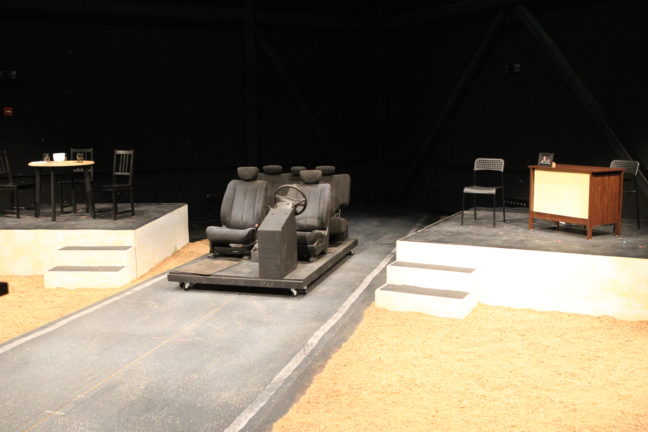From a car that “drove” on stage to a floor covered in cork to an intricate lighting setup, the set of this year’s Upper School Advanced Theater Play, Durango, featured many literal and figurative moving parts. As the capstone project for seniors Christian de Weck ’19, James Morse ’19, and Josh Shapiro ’19 it showcased our technical theater students’ high level of skill.
“This show was a unique project because it didn’t say very much about what it needed to be, but it did have a handful of very specific needs,” said Director of Technical Theater Kenny Burt. “Behind each of the major design decisions came a flood of questions about how to represent details and environments, moods, and themes with appropriate care and attention. Christian, James, and Josh worked together and communicated and executed skillfully in the face of a mountain of detail — hidden behind the show’s simple facade.”
While each of the three students had their own role — Christian with lighting design; James with set design; Josh with technical direction — they all stressed that the final product was the result of a strong collaboration with the entire design team. They reflect on their experience below.
What was your experience working on Durango?
- James: It was absolutely amazing! Seniors from other years had always said that it would be excellent and a capstone to the whole theater experience, but it eclipsed all my expectations. To work on such an awesome team and to have my design realized was truly outstanding.
- Josh: It was a great experience because of the amount of freedom we had on the project. Being able to take James’ ideas [on the set design] and figure out how to build them was the perfect job for me.
- Christian: There is a really nice sense of community that comes when working on any show. This particular production was especially nice because I was familiar with all the seniors. It was certainly a time where I was handed a lot of responsibility — and a lot of creative freedom — as a lighting designer.
What was your favorite part of the process?
- James: The moment that we released the cork out of the bags was incredible. Up until that moment, I had a fear my design wasn’t going to work. But releasing the cork onto the stage not only looked brilliant, but it also completed the set and realized my vision of two platforms and a road emerging out of the Arizona desert.
- Josh: My favorite part of the process was once the road was assembled and we were able to attach the car to the winch system in order to make the car move.
- Christian: Probably testing out all the lights during run-throughs. I was able to formulate the mood I wanted to convey for certain scenes and see what worked best.
What was the most challenging part of the process?
- James: When I was figuring out the first iterations, I was having trouble both visualizing and expressing the set. However, I was able to use Fusion 360 — a CAD program — to model not only the Black Box Theater, but also to quickly visualize the set in 3D. It was a wonderful tool for rapid prototyping and allowed me to explain the set in an instant.
- Josh: Achieving the level of precision we needed to have the car track smoothly across the stage. Any small gap in the wood or wooden pieces that were a bit too close together could be enough to make the car fail to move. It was difficult to build and install knowing that the stakes were high.
- Christian: I would say the most challenging part of this show was probably drawing a lighting plot. I did this in Fusion 360 but it took a lot of critical thinking as to where lights should be placed and why.
Before strike, the students used a 360 camera to document the Durango set. Explore the set below:

